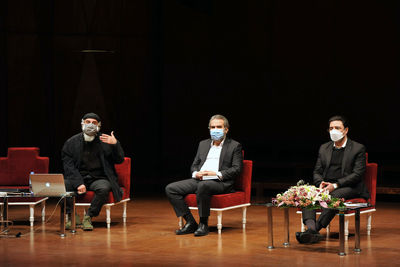The press meeting on restoration and reconstruction of the visual identity of Tehran Museum of Contemporary Arts was held on Monday, January 29, With the presence of Hadi Mozaffari, Visual Arts Office director, Ehsan Aghaei, Director of Tehran Museum of Contemporary Arts, and Zahra Norouzi, Head of Civil Engineering Supervision.
The restoration and expansion of the Tehran Museum of Contemporary Art, which began almost two years ago, have finished and the museum will be open to the public in the coming days, according to Iran’s Visual Arts Office Director Hadi Mozaffari.
He made the statement in a press conference held on Monday on the museum’s restoration.
Information on the exact opening date and further explanations have yet to be announced, he added.
The pandemic along with other matters had slowed down the process of restoration, Mozaffari noted.
He added that the database of museum works had been completed, and its website will be unveiled one day before the reopening of the museum.

Head of Civil Engineering Supervision Zahra Noroozi said "new issues and areas which were added in the last 2 years led to a rise in costs. But due to the importance of this museum to Art Deputy of Ministry of Islamic guidance, 160 billion Rial allocated for studying, supervision, and purchase of equipment" Noroozi said about increasing the costs of reconstruction".
Director of the museum Ehsan Aqaei referred to the issue of the visual identity of the museum, saying, “In general, any specific institution has a visual identity. Before the 1979 Islamic Revolution, a yellow font was used [in the logo]; the current logo of the museum was designed by Javad Pouyan in the early 1990s. Later, Sedaqat Jabbari designed a font based on the previous design. Overall, the museum lacked a visual identity.”
Aqaei said, “Accordingly, we decided to consider a new theme, called Phoenix, for the museum in the new period.”

Iranian graphic designer Reza Abedini was invited to redesign the museum’s visual identity, and the museum’s specific font was also designed.
For the restoration of the museum, the treasured collection was moved to other parts of the museum and none of the items will leave the museum.
The museum organizers said that the best place to store the artwork is the museum itself. The treasures were moved from one gallery to another.
Established in 1977, the museum is notable in the world for its historical narration of art, with the largest collection of Western art that exists in the Orient.






































